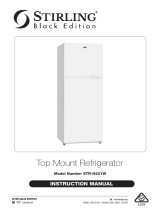
5
5
After Sales Support
(AU) 1300 886 649 (NZ) 0800 836 761 | info@tempo.org
Important Safety Instructions (Cont.)
Cleaning and maintenance
• Disconnect: Switch off and unplug the appliance from the mains socket before
cleaning, maintenance or servicing. Failure to do so can result in electric shock, injury
or death. Do not connect or disconnect the plug when your hands are wet.
• Flames: Do not let open flames or ignition sources enter the appliance.
• Flammable/explosive substances: Never clean this appliance with flammable fluids.
Do not store or use volatile, flammable or explosive substances such as aerosol cans
with a flammable propellants in or close to this or any other appliance. The fumes can
create a fire hazard or explosion.
• Solvents: Do not use solvent based cleaning agents or abrasives on the interior as
these may damage or discolour the surfaces of the appliances.
• WARNING! Do not use mechanical devices or other means to accelerate the defrost-
ing process, other than those recommended by the manufacturer. Never use a sharp or
metal instrument to remove frost or clean the freezer. Use a plastic scraper, if necessary.
• Service: Do not attempt to repair, modify or replace any part of the appliance unless
specifically recommended in this manual. Refer all other servicing to a qualified
service technician, or contact the after sales support centre for advice.
Installation (see page 8 for comprehensive installation instructions)
• Heavy: This appliance is heavy, take care when moving it. To avoid back or other injury,
consider a two person lift or mechanical aid when installing it. Failure to do so can
result in back or other injury.
• Freestanding design: This appliance is designed to be freestanding only and should
not be recessed or built in.
• Keep it upright: Do not tilt the freezer more than 45º from upright when moving it.
• Handle with care: Do not apply force to any part such as the condenser or door.
• WARNING: Ventilation: To ensure proper ventilation, keep any ventilation openings, in
the appliance enclosure or in the built-in structure, clear of obstructions. Ensure adequate
air circulation around the appliance to prevent overheating. Use spacers (if supplied) to
prevent warm parts (compressor, condenser) coming into contact with the wall.
• Level: Install the appliance level in order to ensure proper operation (see page 8).
• Location: Install the appliance in an area that meets the following requirements:
• Ambient temperature: The ambient temperatures must correspond to the climate
class (T) indicated on the rating plate of the appliance (16°C–43°C).
• Floor surface: The floor must be sturdy, level (or nearly level) and strong enough to
support the unit when it is fully loaded. If you must position the appliance on carpet,
use a plastic carpet protector underneath the appliance.
• Areas to avoid: Avoid areas where the appliance would be exposed to direct sunlight,
sources of heat (stove, heater, radiator, etc.), extremely cold ambient temperatures
or excessive moisture and high humidity (such as outdoors or exposed to wind, rain
water spray or drips). Installing it in the coolest area of the room will save energy
consumption and running costs.





















